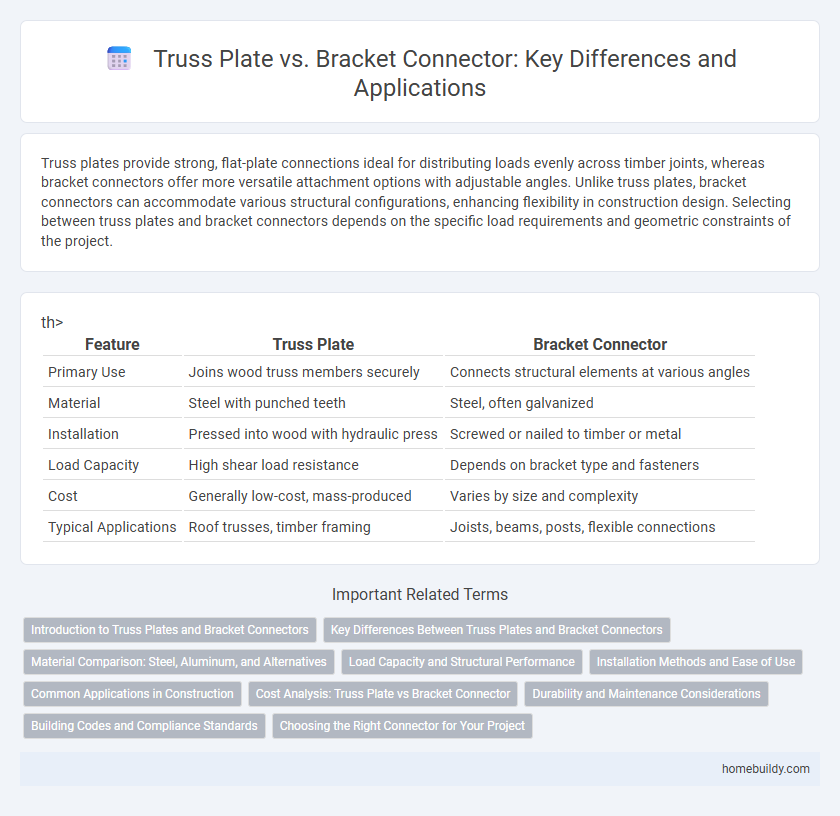Truss plates provide strong, flat-plate connections ideal for distributing loads evenly across timber joints, whereas bracket connectors offer more versatile attachment options with adjustable angles. Unlike truss plates, bracket connectors can accommodate various structural configurations, enhancing flexibility in construction design. Selecting between truss plates and bracket connectors depends on the specific load requirements and geometric constraints of the project.
Table of Comparison
| Feature | Truss Plate | th>Bracket Connector |
|---|---|---|
| Primary Use | Joins wood truss members securely | Connects structural elements at various angles |
| Material | Steel with punched teeth | Steel, often galvanized |
| Installation | Pressed into wood with hydraulic press | Screwed or nailed to timber or metal |
| Load Capacity | High shear load resistance | Depends on bracket type and fasteners |
| Cost | Generally low-cost, mass-produced | Varies by size and complexity |
| Typical Applications | Roof trusses, timber framing | Joists, beams, posts, flexible connections |
Introduction to Truss Plates and Bracket Connectors
Truss plates are galvanized steel connectors designed to join timber members in roof and wall truss systems, providing strong, corrosion-resistant connections. Bracket connectors, often made from steel with various coatings, serve to reinforce joints by offering additional mechanical support where beams and posts meet. Both components are essential in structural frameworks, with truss plates primarily used for load distribution in truss webs and bracket connectors enhancing stability at critical junctions.
Key Differences Between Truss Plates and Bracket Connectors
Truss plates are flat steel connectors with multiple teeth designed to embed into wood for strong, distributed load transfer, whereas bracket connectors are three-dimensional metal pieces used to join wood at specific angles or intersections. Truss plates primarily provide tension and compression resistance in prefabricated trusses, while bracket connectors offer versatile support in various framing applications by reinforcing joints and preventing movement. The choice between truss plates and bracket connectors depends on structural requirements, load distribution needs, and the specific type of wood connection involved.
Material Comparison: Steel, Aluminum, and Alternatives
Truss plates are primarily made from galvanized steel, offering superior strength and corrosion resistance compared to aluminum, which is lighter but less durable under heavy loads. Bracket connectors often use steel or aluminum alloys, with steel providing greater structural stability, while aluminum allows for easier customization and reduced weight in non-critical applications. Alternative materials such as composite plastics and stainless steel are emerging in specialized uses, balancing corrosion resistance and mechanical performance for both truss plates and bracket connectors.
Load Capacity and Structural Performance
Truss plates typically provide higher load capacity due to their large surface area and multiple teeth that distribute forces evenly across the wood members, enhancing structural integrity in truss systems. Bracket connectors, while easier to install and versatile for various joint types, generally offer lower load capacity as they rely on fewer fasteners and concentrated stress points. For demanding structural applications, truss plates are preferred for superior performance under heavy loads and increased resistance to shear and tension forces.
Installation Methods and Ease of Use
Truss plates feature a simple installation method by being pressed or hammered into wood joints without requiring fasteners, offering a faster and more secure connection. Bracket connectors rely on screws or nails, which can increase installation time and require precise alignment for structural integrity. The ease of use of truss plates makes them preferred in large-scale framing projects due to reduced labor and consistent load transfer.
Common Applications in Construction
Truss plates are commonly used in roof and floor framing to connect timber members efficiently and ensure structural stability, especially in residential and light commercial buildings. Bracket connectors are frequently employed for joining beams, posts, and girders in heavy timber construction, providing robust support for load-bearing joints in bridges and industrial structures. Both components are essential for different construction applications, with truss plates favored for their ease of installation in prefabricated trusses and bracket connectors prized for their versatility in complex framing systems.
Cost Analysis: Truss Plate vs Bracket Connector
Truss plates generally offer a more cost-effective solution compared to bracket connectors due to their lower material and installation expenses, particularly in large-scale projects. Bracket connectors often involve higher costs stemming from more complex manufacturing processes and the need for additional fasteners, increasing labor time and overall budget. Cost analysis reveals that truss plates provide greater economic efficiency without compromising structural performance in typical wood framing applications.
Durability and Maintenance Considerations
Truss plates offer superior durability due to their steel composition and corrosion-resistant coatings, ensuring long-term structural integrity with minimal maintenance. Bracket connectors, often made from galvanized steel or aluminum, require more frequent inspections to prevent loosening and corrosion, especially in moist or outdoor environments. Maintenance costs for truss plates are generally lower because their embedded design reduces exposure to external elements compared to bracket connectors.
Building Codes and Compliance Standards
Truss plates and bracket connectors must both adhere to strict building codes such as the International Building Code (IBC) and standards set by the American Wood Council (AWC). While truss plates are typically governed by ASTM standards like ASTM A591 for metal plate connectors, bracket connectors often require compliance with standards such as ICC-ES ESR reports for engineered connectors. Ensuring compliance with these codes is crucial for structural integrity, as truss plates offer continuous load transfer at joints, whereas bracket connectors provide mechanical fastening that must meet specific load and corrosion resistance criteria.
Choosing the Right Connector for Your Project
Truss plates provide high-strength, load-distributing connections ideal for securing timber joints in roof trusses, while bracket connectors offer versatile fastening options suitable for various framing applications. Selecting the right connector depends on factors like load requirements, material compatibility, and ease of installation, with truss plates excelling in engineered wood structures due to their uniform stress distribution. Evaluating project-specific parameters ensures optimal structural integrity and longevity by matching connector type to design demands.
Truss plate vs Bracket connector Infographic

 homebuildy.com
homebuildy.com